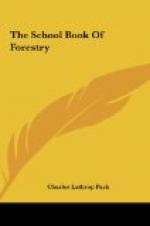After the farm woodland is logged, a new stand of young trees will develop from seeds or sprouts from the stumps. Farmers find that it is profitable to harrow the ground in the cut-over woodlands to aid natural reproduction, or to turn hogs into the timber tract to rustle a living as these animals aid in scattering the seed under favorable circumstances. It is also noteworthy that the most vigorous sprouts come from the clean, well-cut stumps from which the trees were cut during the late fall, winter or early spring before the sap begins to flow. The top of each stump should be cut slanting so that it will readily shed water. The trees that reproduce by sprouts include the oak, hickory, basswood, chestnut, gum, cottonwood, willows and young short-leaf and pitch pines.
In order that the farm woodland may be kept in the best of productive condition, the farmer should remove for firewood the trees adapted only for that purpose. Usually, removing these trees improves the growth of the remaining trees by giving them better chances to develop. Trees should be cut whose growth has been stunted because trees of more rapid growth crowded them out. Diseased trees or those that have been seriously injured by insects should be felled. In sections exposed to chestnut blight or gypsy moth infection, it is advisable to remove the chestnut and birch trees before they are damaged seriously. It is wise management to cut the fire-scarred trees as well as those that are crooked, large-crowned and short-boled, as they will not make good lumber. The removal of these undesirable trees improves the forest by providing more growing space for the sturdy, healthy trees. Sound dead trees as well as the slow-growing trees that crowd the fast growing varieties should be cut. In addition, where such less valuable trees as the beech, birch, black oak, jack oak or black gum are crowding valuable trees like the sugar maples, white or short-leaf pines, yellow poplar or white oak, the former species should be chopped down. These cutting operations should be done with the least possible damage to the living and young trees. The “weed trees” should be cut down, just as the weeds are hoed out of a field of corn, in order that the surviving trees may make better growth.
Often the farmer errs in marketing his tree crops. There have been numerous instances where farmers have been deluded by timber cruisers and others who purchased their valuable forest tracts for a mere fraction of what the woodlands were really worth. The United States Forest Service and State Forestry Departments have investigated many of these cases and its experts advise farmers who are planning to sell tree crops to get prices for the various wood products from as many sawmills and wood-using plants as possible. The foresters recommend that the farmers consult with their neighbors who have sold timber. Sometimes it may pay to sell the timber locally if the prices are right, as then the heavy transportation costs




